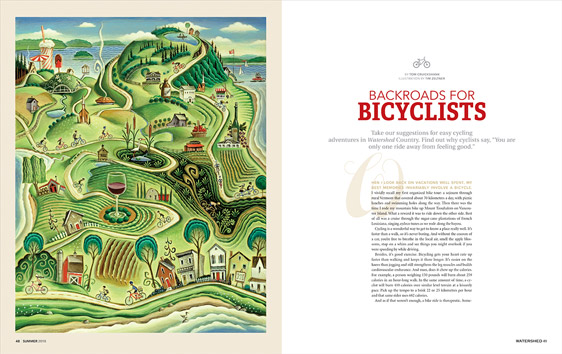
Take our suggestions for easy cycling adventures in Watershed Country. Find out why cyclists say, “You are only one ride away from feeling good.”
WHEN I LOOK BACK ON VACATIONS WELL SPENT, MY BEST MEMORIES INVARIABLY INVOLVE A BICYCLE. I vividly recall my first organized bike tour: a sojourn through rural Vermont that covered about 70 kilometres a day, with picnic lunches and swimming holes along the way. Then there was the time I rode my mountain bike up Mount Tzouhalem on Vancouver Island. What a reward it was to ride down the other side. Best of all was a cruise through the sugar-cane plantations of French Louisiana, singing zydeco tunes as we rode along the bayou.
Cycling is a wonderful way to get to know a place really well. It’s faster than a walk, so it’s never boring. And without the cocoon of a car, you’re free to breathe in the local air, smell the apple blossoms, stop on a whim and see things you might overlook if you were speeding by while driving.
Besides, it’s good exercise. Bicycling gets your heart rate up faster than walking and keeps it there longer. It’s easier on the knees than jogging and still strengthens the leg muscles and builds cardiovascular endurance. And man, does it chew up the calories. For example, a person weighing 150 pounds will burn about 259 calories in an hour-long walk. In the same amount of time, a cyclist will burn 410 calories over similar level terrain at a leisurely pace. Pick up the tempo to a brisk 22 or 25 kilometres per hour and that same rider uses 682 calories.
And as if that weren’t enough, a bike ride is therapeutic. Sometimes, distances might seem daunting and hills might seem formidable, but it’s all about focus: when your mind and body are concentrated on getting up the next hill, somehow all your other everyday troubles seem to vanish. And when the day is done, think of the bragging rights.
But you know what? You don’t have to go as far as Vermont, Vancouver Island or Louisiana to capture that feeling. Last summer, I suggested to some of my city friends that we meet at our country place in Hamilton Township and see where the roads led. We pedalled around my rural neighbourhood, through farmland that was very familiar to me, but new and novel to them. As our reward, we coasted down toward Rice Lake and stopped to put our feet up at the patio at Rhino’s. And there, while waiting for wings and a pitcher, we toasted our accomplishment and conspired to think of some other worthy rides not far from home.
RICE LAKE RENDEZVOUS 32 KM
This cruise through the northern reaches of Hamilton Township introduces you to a lovely rural landscape with frequent views of Rice Lake. This is an under-appreciated corner of Northumberland that comprises a surprisingly flat area called the Rice Lake Plains. Before settlement, it was an open savanna of scrub oak and prairie grass; today, it is part farm country, part cottage country and the perfect antidote to daily stress.
The ride starts and ends in Bewdley, a tourist village at the southwest corner of Rice Lake. For such a small burg, it is well equipped with a convenience store that sells everything from Haagen-Dazs bars to camping supplies, not to mention a takeout pizza joint and two restaurants with outdoor patios. The village even has a public bathroom should the need arise. At the east end of town is an enormous municipal parking lot that can serve as a rendezvous point.
Head east along Cavan Road (the lake will be on your left), which follows a road whose path was trod by aboriginal peoples. Cross the Sackville Bridge, circa 1925, which is the sole remaining “bowstring” bridge in western Northumberland. Follow Cavan Road as far as it goes (about 9 km) through some of the prettiest rolling farmland in the township. At the T-intersection at Plainville, jog right (south) along Burnham Street for less than a kilometre and make a left at Beaver Meadow Road. Another left at Linton Road, merge onto Tinney Road, then take the bend onto McKinlay Road. Head to County Road 9. There, you’ll find a bakery called Lilac Lodge Farm, ideal for a well-deserved break.
Ride east on County Road 9 for about a kilometre. This can be a very busy highway, so use caution. Turn left at Sully Road and enjoy the long glide down to Rice Lake Scenic Drive.
At the base of the hill, our route takes a left turn. If you’re adventuresome, you might detour right for the quick ride into Harwood. It has a general store for snacks, and even better, you can fill up your bottle – free – with cold spring water from the constantly running tap in front of the village hall. Pedal down to the lakeside and you’ll see the remnants of the ill-fated 19th-century railway causeway that was so poorly engineered that it was closed permanently after only one year of use.
Follow Rice Lake Scenic Drive west through cottage country to Gore’s Landing (the lake will be on your right). At every turn, there are cabins and motor courts to remind you of Rice Lake’s early days as a weekend destination. Gore’s Landing is at the heart of it, once the terminus of a steamboat line that plied the Otonabee River to Peterborough.
At the T-intersection, you’ll find a general store. Here, our route takes a left up County Road 18, but you might be tempted to head down Plank Road to the water for a dip at the village dock. Look for the gazebo, which is a modern replica of the one that was built there in the late 1800s.
It’s a long uphill climb along County Road 18. In fact, this is the worst hill on the entire loop. Near the crest, take Lander Road out of Gore’s Landing, back into farm country. There are more views of Rice Lake and you might also notice an historical plaque commemorating the pioneer author, Catharine Parr Traill. Here at Mount Ararat, the highest point on the Rice Lake Plains, she was the first amateur botanist to chronicle the local flora.
Lander Road takes a sharp bend south, away from the lake, and ends at County Road 9. Turn right. Again, this is a busy route, but you’re only on it for a short distance.
Take a left on West Road and follow it down to Cavan Road. Turn right and trace your steps back along Cavan Road to Bewdley.
WHEELING THROUGH WINE COUNTRY 22 KM
Here we offer a ride through the western corner of Prince Edward County. If you don’t know already, this is the local wine country, which sprang out of nowhere in the late 1990s to become the driving force in the local culinary and tourism scene. The secret to its success is partly the climate but also the soil, or perhaps the lack of it, for although it has been farmed for generations, the land is known for a dearth of topsoil. You’ll see as you pedal past the vineyards – some of those grapevines seem to be growing in pure shale.
Our route starts in Wellington and takes the backroads to the village of Hillier, before doubling back to Wellington along the Millennium Trail. This ride affords plenty of opportunities to stop at wineries. En route, there are five of them, with several others a short detour away. All offer tastings for a nominal fee, most in picturesque settings. Signage is good, so don’t be afraid of veering off the beaten path.
Wellington originated as a service centre for local farmers, but at the end of the 19th century, its lakeside breezes made it a favourite for summer tourists. Thanks to the wine trade, it is evolving further today, with upscale dining and boutique shopping. At the end of the ride, you can toast your accomplishment at one of the local eateries, several of which rival their hip city cousins in Toronto.
The rendezvous point is the municipal parking lot behind the town hall on the main street, east of the four corners (look for the green “P” sign). Turn right (west) as you leave the parking lot and pedal through the heart of town. The lake will be on your left.
To avoid the main highway, the ride turns north at Consecon Street. Turn right. Cross the Millennium Trail, but keep its location in mind, as it will be your return route.
Beyond the cemetery, the road veers left into the countryside. Continue and turn left on Danforth Road. Believe it or not, this is the same Danforth Road that runs through the east end of Toronto and through western Northumberland. It was named for Asa Danforth, the surveyor who blazed the route as a military road in 1800.
One of the first wineries you encounter on this tour is Hubb’s Creek or ride a bit further to the Traynor Family Vineyard. Take your pick but remember: it’s a long ride.
Danforth Road winds westward through farm country past Nile’s Corners before it finally ends at Highway 33 (the Loyalist Parkway). Look for the Traynor Family Vineyard at the end of the road. You’ve now done 10 km.
Turn right onto Highway 33 and follow it into the village of Hillier. This is a busy stretch of road, so be sure to use the paved shoulder. There are two landmarks in the village: an old Methodist church and the former township hall – the latter built of stone – at the corner at Station Road.
Turn right on Station Road and pedal out of the village. Stanners Winery will be on your right; Bicentennial Park will be on your left.
Just past the winery, a dip in the road is your cue to turn right onto the Millennium Trail. (Beyond is what was originally a canning factory with a painted sign reading ‘Baldwin Ltd. Swine Division’ – if you see it you’ve gone too far.) Almost immediately you’re riding through a beautiful and extensive wetland that seems miles removed from farm country. Hear the bird calls; savour the views over the marshes. Caution: subject to seasonal flooding.
The Millennium Trail is an off-road, hard-packed path that follows the route of the defunct Prince Edward County Railway from Carrying Place to Picton. Our section of the trail hasn’t yet been improved to the same standards as the sections further east, but it is quite passable and a refreshing ride. Like all rail trails, the grades are gradual, and the curves are broad. Our tour follows it all the way back to Wellington.
Leaving the marsh, the trail takes a wide left and skirts Closson Road. Here, you could opt for a couple more wine tastings by detouring to the north (left): Hinterland (1½ km) and the Grange (3 km). Double back to the trail via Benway Road.
Continue eastbound on the Millennium Trail, and contemplate that the railway on which it runs was never a big financial success. It’s as though its glory days were waiting for the present, when it could serve as a natural scenic link through the County. Your last chance for wine is Trail Estate Winery, a short jog north on Benway Road. Return to the trail and continue east. The last road you cross should look familiar: it’s Danforth Road, where you pedalled earlier.
Follow the trail into Wellington. At Consecon Street, turn right toward the main drag, and return to the starting point. As a reward from a lengthy cycling excursion, and after you’ve safely secured your bikes to the car, and switched from cleats back to sandals, it’s worth taking the time to sample a number of the County’s well-established wineries. A scenic drive back along Greer Road will take you to Casa Dea Estates Winery, Norman Hardie or Rosehall Run Vineyards – all offer a well-deserved ending to a County tour.
OVER THE CLIFF AND BACK AGAIN 20 KM
This brisk ride criss-crosses the North Marysburgh peninsula at the eastern end of the County. It provides a glimpse of everything for which Prince Edward is famous: vistas over the water, varied topography, views of farm country, places to stop for a bite, market stands and of course, wine and even a couple of cideries. It also provides one mother of a hill for which we apologize up front. Indeed, if the hill looks too daunting, you can always start and end your route at the bottom (Keller’s Crossroad). This will also shave 3 km off the total distance travelled.
For the brave, the route starts and ends at Lake-on-the-Mountain, that strangely unique quirk of geography in which a small hill top lake overlooks the Bay of Quinte far below. Within sight of the Glenora ferry, it’s one of the most picturesque scenes in Watershed Country. The view attracts flocks of visitors, sometimes so many that parking can be a problem. If so, drive a little further east and park at the side of the road.
Fortunately, traffic is usually light beyond this point. Pedal east along County Road 7 (the Bay of Quinte will be on your left) through a scrubby table – land of old Loyalist farmsteads. You’ll gain speed as you coast down a long descent through a dramatic rock cut, but beware that at the bottom, the ride takes a hard right turn at Keller’s Crossroad.
Keller’s Crossroad is an old, little-used farm road that connects the north shore of North Marysburgh to the south. Better suited to tractors and jeeps than cars, it is nevertheless a beautiful ride through the woods despite occasional ruts, potholes and wash – outs. Just when you think you’ve ridden into the middle of nowhere, Hayes Inn will appear on your right. This is a beautiful 1830s house that was moved here from its original site at the opposite end of the County by an avowed heritage enthusiast.
Veer left onto the paved County Road 8. This is Waupoos, a rural community whose traditional economy was based on agriculture, apple orchards and the canning industry. It’s still a picturesque scene with several diversions along the way: the Duke of Marysburgh Pub (at the Waupoos Market), Clafeld Cider House, a pick-your-own blueberry patch, and apple markets from the Ostrander and Creasy families, both of whom go back to the County’s Loyalist days. Grandest landmark is the Waupoos Winery, which lies just a little short of the halfway mark of this ride.
At St. John’s Church, look for Bongard’s Crossroad. Turn left and pedal up, up, up. If you can catch your breath long enough, take in the beautiful 1840s stone house on the crest of the hill. Just behind it is the County Cider Co., which not only offers cider tastings and bistro fare, but also provides a fabulous view over Lake Ontario.
Leaving the cidery, turn right and continue north on Bongard’s Crossroad. Past the apple orchards, a blue house will eventually come into view. It marks Bongard’s Corners.
Left at Bongard’s Corners. You’re now back on County Road 7 – the water will be on your right. Before long, you’ll see Devil’s Wishbone Winery, your last chance for a wine tasting. You’ll need some courage because just beyond is Keller’s Crossroad and a trip up that aforementioned notorious hill.
Return to Lake-on-the-Mountain.
SECRETS OF A SUCCESSFUL RIDE
-
If you’re not in great shape to begin with, don’t over-exert yourself. Pedal out half an hour from home, making sure you have enough stamina for the return trip. And drink plenty of water as you go. (If you wait until you feel thirsty, you’re already getting dehydrated.) Stretch your legs when the ride is through. As your endurance improves, you’ll be surprised how far you ca n pedal with relatively little effort.
-
Stay off the main highways. Even the so-called less-travelled byways, such as Highways 2, 62 and 33 carry more traffic than all but the most seasoned cyclist is willing to risk. Fortunately, there are lots of alternatives. The best routes are county and township roads that are paved but not nearly as busy. Fortunately, these also are the most scenic.
-
Have a destination in mind. In fact, pick the destination first: a park for a picnic, an ice-cream parlour, an outdoor pub – and plan the route accordingly.
-
Don’t be competitive. Nothing takes the fun out of cycling faster than trying to keep up to the wise guy who thinks a leisurely Saturday ride is the Tour de France.
Story by:
Tom Cruickshank


